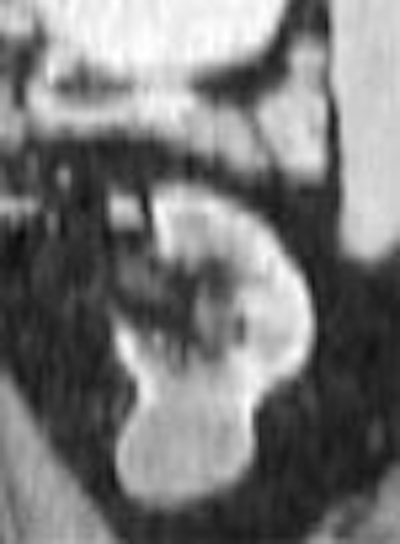
Unsuspected extracolonic cancers are found in about one in 300 asymptomatic virtual colonoscopy (VC) screening subjects, according to a new study of more than 5,000 individuals who underwent colon cancer screening. The results add weight to the argument that following up the most serious extracolonic findings can potentially benefit outcomes.
The study, likely the largest to date to examine the frequency and types of extracolonic cancers seen at VC (or CT colonography [CTC]), also found unsuspected cancers of the colon in about one in 500 patients -- although the main goal of colorectal screening in the U.S. is to find so-called precursor lesions, particularly adenomatous polyps 1 cm and larger that have not yet progressed to cancer.
The study was presented at the 2007 American Roentgen Ray Society (ARRS) meeting by Dr. Ryan Meiners, a radiology fellow at the University of Wisconsin Hospital and Clinics in Madison, WI. Meiners and his co-investigators Dr. Perry Pickhardt, associate professor of radiology; Dr. David Kim; Dr. Andrew Taylor; and Dr. Meghan Hanson, examined 5,019 consecutive asymptomatic adults (2,611 women, 2,408 men; mean age 57.2) who had undergone virtual colonoscopy at the center, followed when needed by conventional colonoscopy and polypectomy.
The day before the exam, screening subjects underwent purgative bowel cleansing and a fecal and fluid-tagging regimen consisting of sodium phosphate (45 mL), 2% barium suspension (250 mL), and diatrizoate (60 mL).
Abdominal images from the lower chest to the base of the lungs were acquired on a 16-detector-row scanner (LightSpeed, GE Healthcare, Chalfont St. Giles, U.K.) using 1.25-mm collimation, 1-mm reconstruction intervals, 120 kVp, and 50-75 mAs. Postprocessing and primary 3D interpretation were performed on a V3D colon workstation (Viatronix, Stony Brook, NY).
 |
| An asymptomatic 55-year-old man had multiple sclerotic lesions throughout the lower lumbar spine. CT found no abnormalities except for retroperitoneal adenopathy. The patient was referred for serum PSA testing and the results exceeded 7,000 µg/L. The patient was diagnosed in February 2007 with stage IV metastatic prostate cancer. Since diagnosis, he has undergone only hormonal treatment. All images courtesy of Dr. Ryan Meiners and Dr. Perry Pickhardt. |
"We only get a small portion of the lungs in our images, and the bottom of the heart," Meiners said in an interview with AuntMinnie.com.
At the clinic, the search for extracolonic findings is performed immediately after primary 3D interpretation of the colon data, and with thicker reconstructions. "We reformat them at 5 mm and read them," he said. "We find (thicker slabs) easier to read, and that's what goes on our PACS workstation; the 1.25-mm source data aren't even put on our PACS."
 |
| At VC, extracolonic CT images suggested abnormal mesenteric lymphadenopathy. Stage 1 lymphoma was confirmed at surgery. |
Medical records for each case were reviewed to document the diagnoses and workup of extracolonic malignancies, as well as patient outcomes including mortality.
"Extracolonic findings are classified according to C-RADS (CT Colonography Reporting and Data System), E1-E4 which characterizes how significant a finding is," Meiners said. "I searched the database for E3 and E4 lesions, then did a medical record review to find out what workup was done and what the eventual diagnoses were."
 |
The researchers found unsuspected extracolonic malignancies diagnosed in 17 (0.34%) patients (9 men, 8 women). "In the same 5,000 patients, we found 10 colonic malignancies that were also unsuspected," Meiners added.
Extracolonic malignancies included:
- Non-Hodgkin's lymphoma (n = 5)
- Bronchogenic carcinoma (n = 4)
- Renal cell carcinoma (n = 4)
- Ovarian carcinoma (n = 1)
- Gastric GIST (n = 1)
- Metastatic endometrial carcinoma (n = 1)
Treatments included:
- Surgery (n = 8)
- Chemotherapy (n = 5)
- Radiation therapy (n = 2)
- Hormonal therapy (n = 1)
- Other (n = 2)
- None (n = 4)
 |
| A man in his 70s underwent CT colonography screening; MDCT revealed a large renal mass. Workup also revealed multiple lung nodules. He was diagnosed with metastatic renal cell carcinoma; however, no intervention has been performed due to multiple comorbidities, and the patient has done well. |
At virtual colonoscopy screening of asymptomatic patients, unsuspected cancers are found in about one of every 200 patients, including extracolonic malignancies in about one of 300 and unsuspected colon cancers in one of every 500 patients, Meiners said.
 |
"When you put in those numbers, it does seem significant," he said. "But because we're doing noncontrast studies, we're basically picking up fairly sizeable lesions. We're not really ready to take the step of saying what it means."
 |
| CT images of a 54-year-old woman revealed an opacity at the right lung base. The radiologist recommended a dedicated chest CT, which revealed abnormalities in the mediastinum; the patient subsequently underwent PET, and a biopsy confirmed lung cancer, stage IIIa. The patient was doing well following surgery, chemotherapy, and radiation. |
After all, "there's no good data that show the effectiveness or cost-effectiveness of whole-body screening, and there's a huge debate going on right now about the workup of extracolonic findings, and a lot of papers saying there's too much added burden" involved in the workup of incidental findings, Meiners said.
Still, finding malignancies "shows there can be some benefit, a silver lining for the workup of unsuspected findings," he said. "(Pickhardt) would argue that if you actually work up extracolonic findings in a prudent common-sense fashion, then the cost really isn't that much. The other benefit was that all 27 of those patients were still alive at the time of our most recent follow-up."
 |
There could be a survival benefit due to finding unsuspected cancers at an earlier stage. But lead-time bias could have skewed the results, particularly in patients with the shortest follow-up times, Meiners said. More follow-up will be needed across the board to assess the impact of the interventions, Meiners said. As of February 2007, the mean follow-up time was 16 months (range, 3-36 months), he said.
Unsuspected colorectal cancer is seen in approximately one of every 500 asymptomatic adults, and the overall detection rate of unsuspected cancer is about one in 200 asymptomatic adults, the group concluded.
"It remains unproven as to whether or not the incidental extracolonic evaluation at VC represents a net benefit," Pickhardt wrote in an e-mail to AuntMinnie.com. "However, there is no doubt that we are identifying unsuspected extracolonic cancers and aneurysms before they become symptomatic, which presumably leads to a better outcome and cost savings in these patients."
By Eric Barnes
AuntMinnie.com staff writer
June 12, 2007
Related Reading
Screening model calls VC most cost-effective colon exam, April 24, 2007
Higher costs seen in post-VC extracolonic follow-up, November 3, 2006
Low incidence of serious extracolonic findings seen in VC screening population, December 18, 2006
Extracolonic lesions: Find them if you can, October 30, 2006
Extracolonic findings double VC costs, but might be worth paying, July 20, 2006
Copyright © 2007 AuntMinnie.com




















